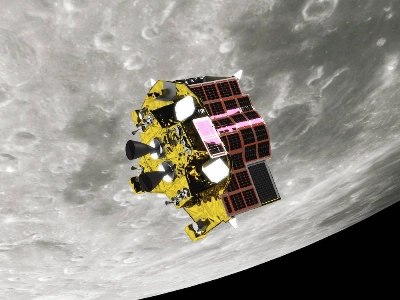Japan's lunar lander completed a successful touchdown on the moon’s surface just after midnight on Saturday, but a technical issue related to the craft's ability to use solar power has made it uncertain whether the mission will achieve all of its goals.
With the landing, Japan becomes just the fifth country to land a craft on the moon, after the U.S., Russia, China and India.
Japan Aerospace Exploration Agency (JAXA) officials said they have good reason to believe that the Smart Lander for Investigating Moon spacecraft made a soft landing and achieved its goal of a high-precision landing, though they said they will need more time to confirm whether the lander achieved the goal of landing within 100 meters of its target site.
“The data are continually being sent to the Earth now after landing, which is evidence that our goal of a soft landing has been achieved,” JAXA President Hiroshi Yamanaka told a news conference at the agency’s campus in Sagamihara, Kanagawa Prefecture, in the wee hours of Saturday morning.
JAXA officials, however, said that the solar panels on the lander were not generating power and the lander was being powered by its onboard battery, which would have only lasted for several hours.
They added that the lack of electricity from solar panels may limit the duration of the lander’s activities, but said they would do their best to accomplish as much as they can with the power they have. The end of battery power does not mean the end of the mission, the officials stressed.
Officials do not believe the solar panels were damaged during the landing given that the rest of the spacecraft is intact, and noted that as the angle of the sun changes in the weeks ahead, the panels may start generating electricity.
Had the solar panels been working properly, the lander would have been able to operate for "several days," before the panels suffered damage from the moon's daytime temperatures, which can rise to about 100 degrees Celsius, the officials said.
JAXA had planned to have the lander analyze the mineral olivine on the lunar surface, which could reveal key information about the origin of the moon. But because of the power issue, the mission will prioritize sending data back to Earth to determine whether the craft achieved a pinpoint landing, and there is a possibility the mineral survey will not proceed as planned.
Tension rose at midnight Saturday as the spacecraft began its final descent, dubbed the “20 minutes of terror,” in the closely watched last stage of the spacecraft’s four-month journey to the moon.
At around 12:20 a.m., as people watched from around the world, the spacecraft nicknamed “Moon Sniper” successfully landed on the lunar surface.
But reporters and space enthusiasts who watched a livestream of the landing attempt early Saturday morning were kept waiting for nearly two hours without confirmation of the landing as officials repeated only that they were still trying to confirm the status of the spacecraft.
Then, at a news conference that started a little after 2 a.m. Saturday, three JAXA executives appeared with glum looks on their faces, saying they had yet to nail down the cause of the solar power problem.
Asked by a reporter to rate the mission’s performance, Hitoshi Kuninaka, director general of JAXA’s Institute of Space and Astronautical Science (ISAS), said: “I would give 60 points out of 100 — we barely passed the test.”
The touchdown on the moon — which has one-sixth of the Earth’s gravity — gives a much-needed boost to Japan's space program, which has experienced a series of setbacks in recent years including the launch failure of its H3 flagship rocket in March 2023.
Prime Minister Fumio Kishida praised JAXA's efforts in adding Japan to the select group of countries to land a craft on the moon.
"We would like to express our respect to everyone involved for their efforts thus far, and we will continue to support them as they take on further challenges," Kishida wrote on the X social media platform.
At the news conference, another JAXA official expressed hope that the mission will encourage younger generations to aim high in whatever they aspire to do.
“To land on the moon is an extremely difficult challenge,” said Masaki Fujimoto, deputy director general of JAXA’s ISAS.
“I want children to tackle challenging projects such as this and pursue their own interests.”



















With your current subscription plan you can comment on stories. However, before writing your first comment, please create a display name in the Profile section of your subscriber account page.